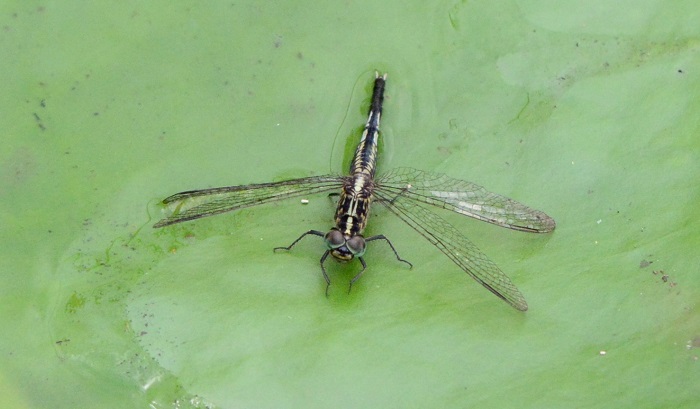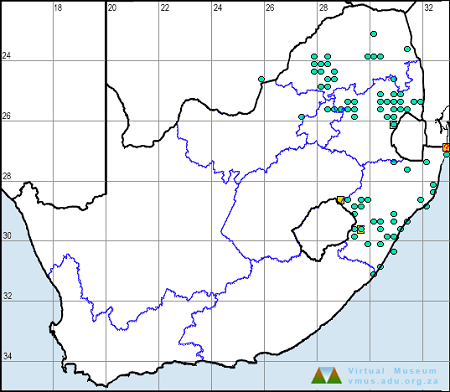Cover photo by Wayne Johnston.
Find this species in the FBIS database (Freshwater Biodiversity Information System) here.
Family Libellulidae
Identification

Okavango Delta, Botswana
Photo by Ryan Tippett
Small size
Hindwing – 22mm.
The Stout Pintail is easily recognised as an Acisoma species by the swollen abdomen base that tapers off sharply from segment 6 down to the tip.
The Stout Pintail is most similar to the Slender Pintail (Acisoma variegatum). The two species bear a close resemblance to one another and co-occur at many sites.
The most conclusive way to separate the two is the colouration difference, on the S4 ventral corner, along the sides of the abdomen. In Acisoma variegatum the ventral corner is mostly white, while it is edged with black in Acisoma inflatum. Additionally, the S5 lateral carina is partly white in Acisoma variegatum and all-black in Acisoma inflatum.
Acisoma variegatum shows segments 6 and 7 of equal length, while in Acisoma inflatum segment 6 is shorter than segment 7.
The Stout Pintail also tends to be slightly smaller and somewhat duller in colour, sometimes showing a yellowish-brown wash on the thorax.
Click here for more details on identification.

Lake Naverone, KwaZulu-Natal
Photo by Ryan Tippett
Habitat
Stout Pintails inhabit marshes and floodplains with pools supporting a rich growth of aquatic plants, particularly sedges, reeds, and grasses. The Stout Pintail is sometimes also found along slow-moving sections of rivers. The Stout Pintail is often found where there are floating plants like water lilies amongst the emergent vegetation.

Photo by Ryan Tippett
Behaviour
The Stout Pintail sits close to the water on floating or emergent plant stems. It hunts from a perch and quickly resettles again. The flight is fast and wasp-like.

Kosi Bay, iSimangaliso Wetland Park, KwaZulu-Natal
Photo by Ryan Tippett
Status and Conservation
The Stout Pintail is locally common in South Africa. It is listed as of Least Concern in the IUCN Red List of Threatened Species. The Stout Pintail is most common in natural habitats but will make use of suitable man-made sites like dams and ponds.

Lake Naverone, KwaZulu-Natal
Photo by Ryan Tippett
Distribution
Acisoma inflatum occurs widely across the savanna regions of Sub-Saharan Africa. It also occurs very locally along parts of the Mediterranean coastline of North Africa.
In South Africa, the Stout Pintail is found in the higher rainfall areas of the north and east.

Kosi Bay, iSimangaliso Wetland Park, KwaZulu-Natal
Photo by Ryan Tippett
Below is a map showing the distribution of records for Stout Pintail in the OdonataMAP database as at February 2020.

Below is a map showing the distribution of records for Stout Pintail in the OdonataMAP database as of December 2024.

The next map below is an imputed map, produced by an interpolation algorithm, which attempts to generate a full distribution map from the partial information in the map above. This map will be improved by the submission of records to the OdonataMAP section of the Virtual Museum.


Ultimately, we will produce a series of maps for all the odonata species in the region. The current algorithm is a new algorithm. The objective is mainly to produce “smoothed” maps that could go into a field guide for odonata. This basic version of the algorithm (as mapped above) does not make use of “explanatory variables” (e.g. altitude, terrain roughness, presence of freshwater — we will be producing maps that take these variables into account soon). Currently, it only makes use of the OdonataMAP records for the species being mapped, as well as all the other records of all other species. The basic maps are “optimistic” and will generally show ranges to be larger than what they probably are.
These maps use the data in the OdonataMAP section of the Virtual Museum, and also the database assembled by the previous JRS funded project, which was led by Professor Michael Samways and Dr KD Dijkstra.

Okavango Delta, Botswana
Photo by Ryan Tippett
Phenology



Kosi Bay, iSimangaliso Wetland Park, KwaZulu-Natal
Photo by Ryan Tippett
Further Resources
The use of photographs by Wayne Johnston is acknowledged. All other photos by Ryan Tippett.
Stout Pintail Acisoma inflatum Selys, 1882
Other common names: Grizzled Pintail (Alt. English); Dikpylstertjie (Afrikaans)
Recommended citation format: Loftie-Eaton M; Navarro R; Tippett RM; Underhill L. 2025. Stout Pintail Acisoma inflatum. Biodiversity and Development Institute. Available online at https://thebdi.org/2020/06/09/stout-pintail-acisoma-inflatum/
References: Tarboton, M; Tarboton, W. (2019). A Guide to the Dragonflies & Damselflies of South Africa. Struik Nature.
Samways, MJ. (2008). Dragonflies and Damselflies of South Africa. Pensoft
Samways, MJ. (2016). Manual of Freshwater Assessment for South Africa: Dragonfly Biotic Index. Suricata 2. South African National Biodiversity Institute, Pretoria
Martens, A; Suhling, F. (2007). Dragonflies and Damselflies of Namibia. Gamsberg Macmillan.

Lake Naverone, KwaZulu-Natal
Photo by Ryan Tippett

